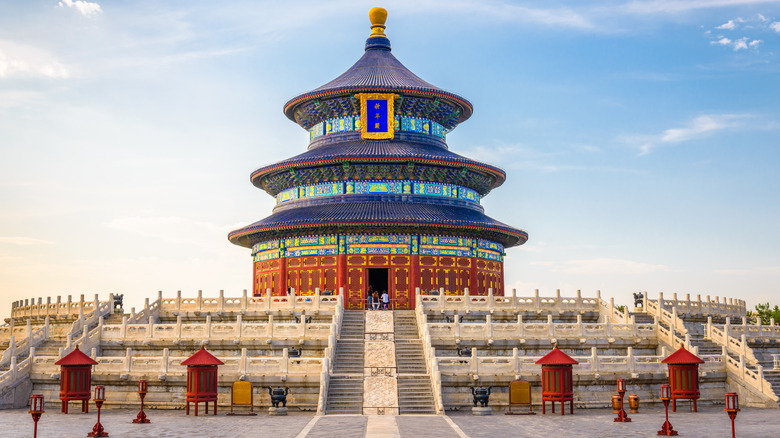Every day, tens of thousands of theme park visitors walk past detailed replicas of global landmarks in EPCOT’s World Showcase area. Depending on how well-traveled you are beyond Disney World, you may already recognize certain landmarks. Outside the Eiffel Tower, however, World Showcase sometimes eschews the most obvious landmarks it could have recreated for ones that casual vacationers may not know by name. Some pieces of architecture also contain visual elements that show the influence of real places without being exact replicas. Investigating the original sights that inspired EPCOT’s simulated environments can be a fun way to expand your travel experience abroad, or just gain a deeper appreciation for what you’re seeing in Florida at Disney.
Whether you go clockwise or counterclockwise around the central lagoon, World Showcase and its pavilions act as a vicarious tour of 11 countries. Together, they’re enough to take up the whole back half of EPCOT. The front half, formerly divided into Future World East and West, has since incorporated a Polynesian-inspired “Moana” attraction, retheming its areas to World Nature, World Celebration, and World Discovery.
You can eat and drink your way through World Showcase during the International Food and Wine Festival, or just ride your way through attractions like Frozen Ever After and Remy’s Ratatouille Adventure (which tend to draw the longest waits of any two rides in the park). The pavilions and their landmarks are based on destinations in Mexico, Norway, China, Germany, Italy, America, Japan, Morocco, France, the United Kingdom, and Canada.
Mexico and Norway
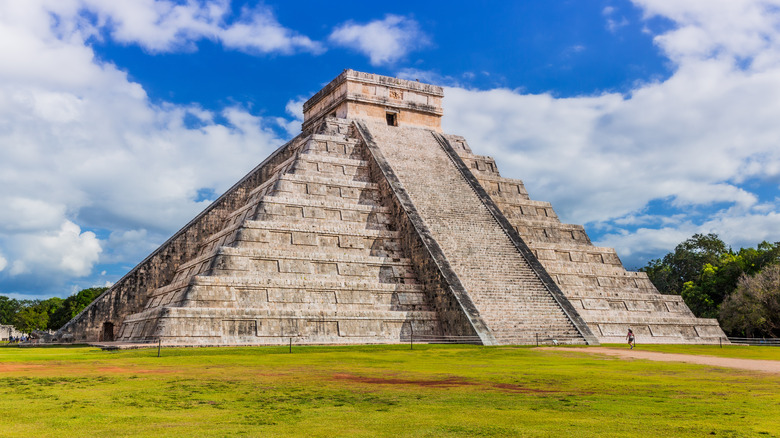
EPCOT visitors who head straight for Frozen Ever After might breeze right past Mexico, the first clockwise pavilion in World Showcase. Yet it’s hard to miss the sight of its pyramid, which is based partly on the Mayan step pyramid, El Castillo, a.k.a. the Temple of Kukulcan. El Castillo is one feature of Mexico’s most-visited archeological site, Chichen Itza. Since they’re both located on the Yucatan Peninsula, it’s often paired with a trip to the popular beachfront mecca of Cancun.
Inside EPCOT’s Mexico pyramid, you’ll see a second pyramid that resembles El Castillo even more. It looms over San Angel Inn Restaurante, which takes its name from a real restaurant in Mexico City. The same company operates both restaurants, so if you can’t make it to Mexico’s capital, the next best thing might be enjoying some authentic San Angel Inn cuisine in World Showcase.
Next to the Mexico pavilion is Norway, where Gol Stave Church (preserved at the Norwegian Museum of Cultural History in Oslo) lends its name and roof design to the towering Stave Church Gallery. The Royal Sommerhus cabin, where Anna and Elsa from “Frozen” greet EPCOT visitors, is modeled on Detli House at the Sverresborg Trondelag Folk Museum in Trondheim. The museum adjoins the ruins of the oldest medieval castle in Norway, while the house stands as an open-air exhibit like Gol Stave Church. You’ll also see some slanted red buildings in the Norway pavilion that evoke the UNESCO World Heritage Site of Bryggen.
China, Germany, and Italy
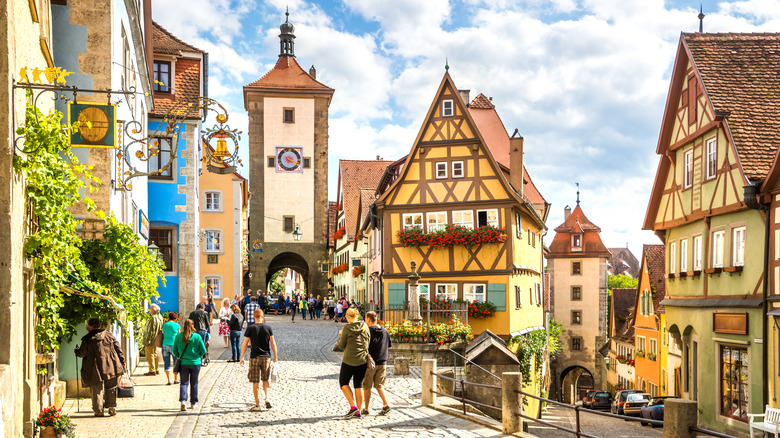
EPCOT’s Reflections of China attraction is housed inside a replica of the Temple of Heaven in Beijing. The structure of the temple’s Hall of Prayer for Good Harvests — which looks like a round, blue, three-story pagoda — makes it a perfect venue for Disney’s 360-degree Circle-Vision film. One place shown in the film is the water town of Suzhou. Like Bryggen and the Temple of Heaven, the classical gardens of Suzhou are a UNESCO World Heritage Site, and they’re said to have inspired the China pavilion’s garden and lotus pond. The real gardens are west of Shanghai in Jiangsu.
The Germany pavilion recreates the statue of St. George and the Dragon from the picture-perfect Bavarian town of Rothenburg ob der Tauber. This same town inspired the village in the Disney animated film “Pinocchio,” and you can see visual echoes of it throughout the rest of the pavilion. It gives Disney fans even more incentive to visit Bavaria, where Neuschwanstein Castle famously inspired Sleeping Beauty Castle, the centerpiece of California’s Disneyland.
Seeing Pinocchio’s village in Germany may feel odd, since the story was originally Italian and inspired by a one-of-a-kind magical tree in Tuscany. EPCOT puts it right next door to its Italy pavilion, however, and there, you can find duplicates of two well-known Venice landmarks, Doge’s Palace and the bell tower St. Mark’s Campanile. To help regulate overcrowding (which gets as bad as Disney World sometimes), the real Venice will soon implement an entry fee for daytrippers.
The American Adventure and Japan
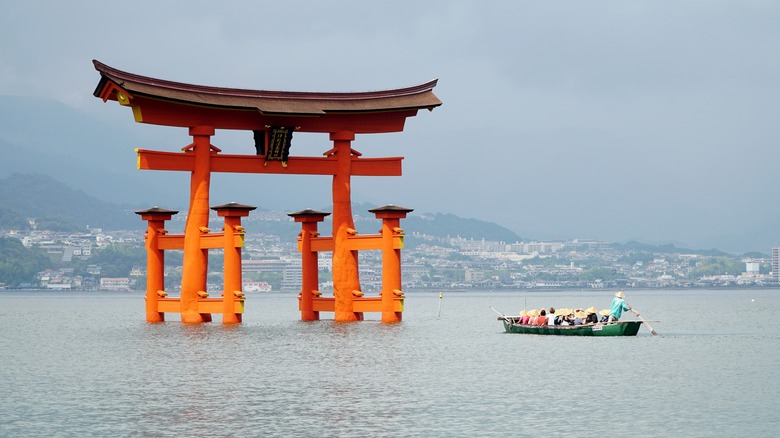
ErenMotion/Shutterstock
The attraction that gives The American Adventure pavilion its name sits inside a brick building based on Boston’s Old State House and Philadelphia’s Independence Hall. Both places are National Historical Parks with prominent clocks like the one in the pavilion (which itself commands the 12 o’clock spot in World Showcase). The attraction also depicts the Boston Tea Party, which has a museum dedicated to it on the Congress Street Bridge in Boston. Disney drew further inspiration from two historic Virginia sites you can visit: Colonial Williamsburg and Thomas Jefferson’s Monticello estate. To see a bronze version of the third U.S. president (instead of an Audio-Animatronic one), you can always combine Virginia with a trip to Washington, D.C. and the Jefferson Memorial.
The five-story pagoda in EPCOT’s Japan pavilion references the one at Horyuji Temple in Nara. This temple holds the Guinness World Record for “Oldest wooden building.” The torii gate in World Showcase Lagoon, meanwhile, is a tribute to the floating gate at Itsukushima Shrine in Hiroshima. A must-visit for foodies and theme park lovers is Hiroshima’s multi-level okonomiyaki village, Okonomimura.
EPCOT’s sushi bar and grill, Shiki-Sai, has okonomiyaki on the menu, too, and right downstairs from it is a branch of Japan’s oldest department store, Mitsukoshi. The original Mitsukoshi beckons shoppers to Nihonbashi, Tokyo. Another nearby pavilion restaurant, Katsura Grill, takes its name from the Katsura Imperial Villa in the suburbs of Kyoto. This villa’s gardens inspired the one that surrounds the restaurant patio.
Morocco and France
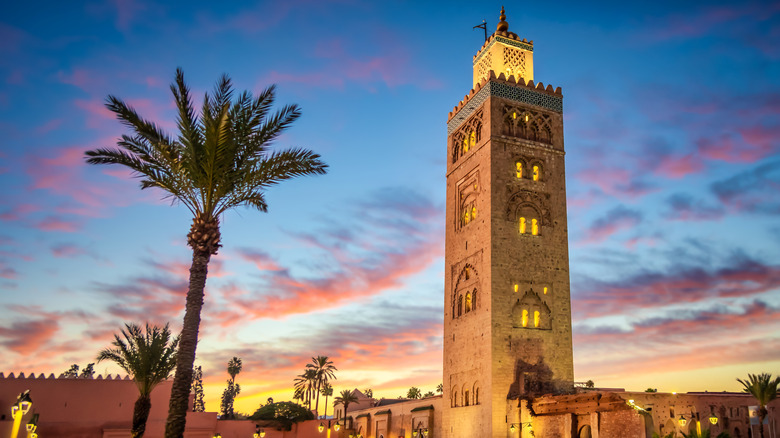
Eloi_omella/Getty Images
In the Morocco pavilion, you can see the “Blue Gate of Fez,” Bab Bou Jeloud, recreated. The actual gate in Fez leads to the city’s medina, or old walled town. However, it’s the medina in Marrakesh that’s associated with the pavilion’s tallest feature: a clone of the Koutoubia Minaret. A minaret is a mosque tower where the Muslim call to prayer is made five times daily. The Koutoubia Minaret is attached to the Mosque of the Booksellers in Marrakesh. Tourists can see the mosque from the outside, but only Muslim worshippers are allowed to enter.
Tokyo DisneySea has similar replicas of the minaret and the Blue Gate of Fez positioned beside each other in its Arabian Coast area. EPCOT’s Morocco pavilion also nods to medina history in the restaurant Tangierine Cafe: Flavors of the Medina. The Moroccan government used to personally sponsor the pavilion until Disney took it over in 2020.
EPCOT’s Eiffel Tower replica rises over its France pavilion from the background, so it’s not quite as photogenic as the original. On the plus side, however, you don’t have to worry about copyright law when sharing night photos of it like you would with the real Eiffel Tower in Paris. The bakery Les Halles Boulangerie-Patisserie, which offers EPCOT’s best food deal, is appropriately named after the one-time central food market in Paris. For 200 years, Les Halles was a thriving hub in France’s capital, but the Westfield Forum des Halles shopping center has since replaced it.
The United Kingdom and Canada
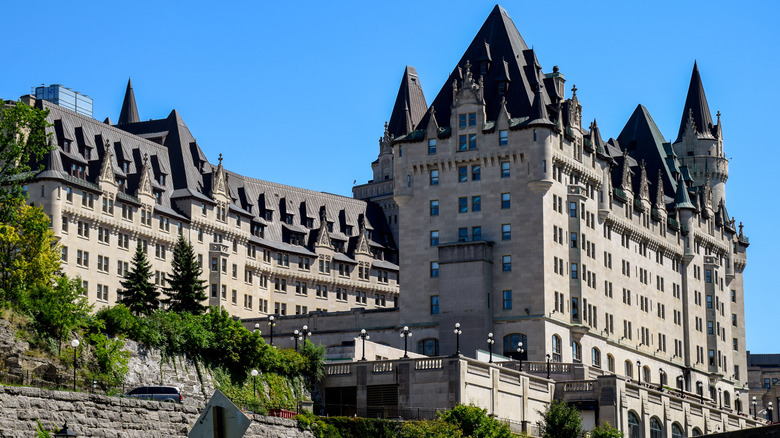
Juliealexk/Getty Images
The Sportsman’s Shoppe in EPCOT’s United Kingdom pavilion mirrors the facade of Hampton Court Palace, one of Henry VIII’s homes, in Greater London. Though Oscar winner Anne Hathaway has appeared in her fair share of Disney movies, it’s the 16th-century Anne Hathaway — Shakespeare’s wife — whose cottage influenced the look of the pavilion’s Tea Caddy gift shop. The cottage now operates seasonally as a historical museum in Shakespeare’s hometown, Stratford-upon-Avon, a popular day trip destination from London. It includes a trail of sculptures based on his stage plays.
The colorful gardens in the Canada pavilion, the final stop in a clockwise tour of World Showcase, are a facsimile of the Butchart Gardens in Victoria, British Columbia. These gardens are less than a 30-minute drive from Hatley Castle, another National Historic Site that’s known for its many movie appearances. The bridge leading back to the waterfall in the Canada pavilion echoes the trail from Johnston Canyon to Lower Falls in Alberta’s Banff National Park. You’ll have to head to Ottawa to find the Fairmont Chateau Laurier, the source of inspiration for the pavilion’s biggest landmark, the Hotel du Canada.
World Showcase has many other nooks and crannies where you may see the influence of real-life places, but you can also use it as a true International Gateway (like the name of EPCOT’s ferry terminal) to explore other countries. Disney can even help with that adventure since its cruise line offers itineraries to some of the same countries.

